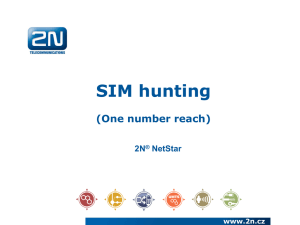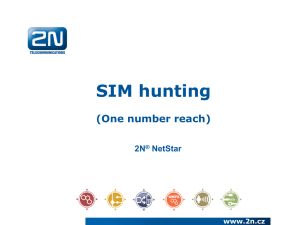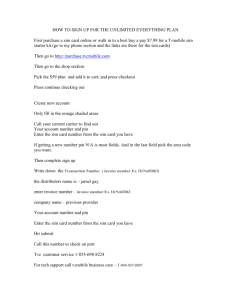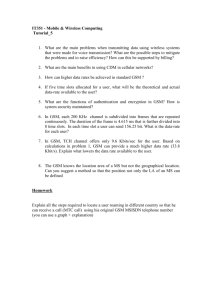to view the PowerPoint Presentation
advertisement
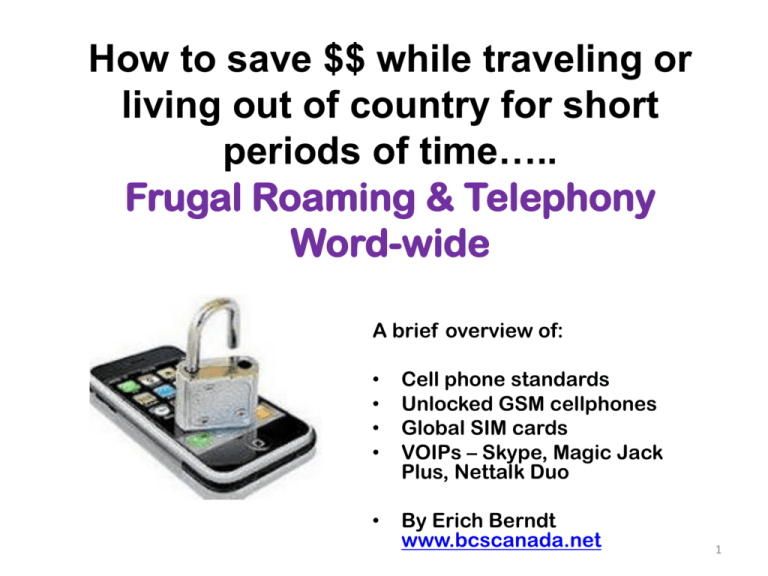
How to save $$ while traveling or living out of country for short periods of time….. Frugal Roaming & Telephony Word-wide A brief overview of: • • • • Cell phone standards Unlocked GSM cellphones Global SIM cards VOIPs – Skype, Magic Jack Plus, Nettalk Duo • By Erich Berndt www.bcscanada.net 1 Don’t get dinged by Canada’s high roaming rates By OSH O’KANE Globe and Mail Update Posted on Thursday, August 4, 2011 8:44PM EDT Roaming Rates EU roaming rates as of July 2011: Prices for mobile roaming calls are reduced further with a maximum tariff of €0.35 per minute for calls made and €0.11 per minute for calls received. The maximum wholesale prices for data roaming fall from €0.80 to €0.50 per MB. Receiving a voice mail message while roaming will be free of charge. • Typical (Rogers – GSM/G2) US Roaming Offer With mobility contract 3 Telus Promotional International Roaming Charges on CDMA (2G + HSPA/3G) Networks – with mobility contract SMS – short message service – “texting” 4 Types of Cell Phones & Acronym Confusion Acronym What is it? GSM (2G) GSM (Global System for Mobile Communications) is a standard set developed by the ETSI to describe technologies for second generation (or "2G") digital cellular networks. . "GSM" is a trademark owned by the GSM Association – Rogers, Fido in Canada – several carriers in the US – most of the rest of the world – hence the term “world phone” for GSM cell phones. CDMA (2G) CDMA also known as IS-95 was developed by Qualcomm - Code division multiple access (CDMA) is a channel access method used by various radio communication technologies – Telus & Bell CDMA2000 (3G) WCDMA (3G)etc. CDMA should not be confused with the mobile phone standards called cdmaOne (2.5G), CDMA2000 (the 3G evolution of cdmaOne) and WCDMA (the 3G standard used by GSM carriers), which are often referred to as CDMA, and use CDMA as an underlying channel access method. UMTS (3G) Universal Mobile Telecommunications System (UMTS) is a third generation mobile cellular technology for networks based on the GSM standard. UMTS is used primarily in Europe, Japan, China and other regions using GSM 2G. The cell phones are typically UMTS and GSM hybrids. HSPA HSPA+ provides an evolution of High Speed Packet Access and provides data rates up to 84 Megabits per second (Mbit/s) to mobile devices and 22 Mbit/s from mobile devices –these speeds degrade as distance from towers increases. - HSPA+ currently in use in Canada, Rogers, Fido, and even Telus and Bell (56Mbit/s downlink & 22 Mbit/s uplink speed). It is the latest version of UMTS. (an advanced version of WCDMA) (aka 3G+) LTE – 4G LTE Advanced (Long-term-evolution Advanced) - 4G standards - peak speed requirements for 4G service at 100 Mbit/s for high mobility communication (such as from trains and cars) and 1 Gbit/s for low mobility communication (such as pedestrians and stationary users). Recently some versions of 3G have been allowed to use the 4G designation but for purists are not true 4G – e.g. the iPhone 4 is only capable of a theoretical maximum speed of 7.2 Mbps, according to Bell. (An iPhone 4 is a fourth-generation iPhone, but is only capable of 3G speeds.) Telus & Bell, Rogers & Fido 5G -– In the future……..faster…further…friendlier… frugal???? it’s all about speed!! 5 Strengths and Weaknesses of IS-95 (CDMA) and GSM Advantages of GSM GSM is mature; this maturity means a more stable network with robust features. Less signal deterioration inside buildings. Ability to use repeaters. The availability of Subscriber Identity Modules allows users to switch networks and handsets at will, aside from a subsidy lock. GSM covers virtually all parts of the world so international roaming is not a problem. The much bigger number of subscribers globally creates a better network effect for GSM handset makers, carriers and end users. Disadvantages of GSM Interferes with some electronics, especially certain audio amplifiers. Intellectual property is concentrated among a few industry participants, creating barriers to entry for new entrants and limiting competition among phone manufacturers. Situation is however worse in CDMA-based systems like IS-95, where Qualcomm is the major IP holder. GSM has a fixed maximum cell site range of 120 km. This is expanded from the old limit of 35 km. 6 Strengths and Weaknesses of IS-95 (CDMA) and GSM cntd. Advantages of IS-95 (CDMA – 2G) • • • • • • • Capacity is IS-95's biggest asset; it can accommodate more users per MHz of bandwidth than any other technology. Has no built-in limit to the number of concurrent users. Uses precise clocks that do not limit the distance a tower can cover. Consumes less power and covers large areas so cell size in IS-95 is larger. Able to produce a reasonable call with lower signal (cell phone reception) levels. Uses soft handoff, reducing the likelihood of dropped calls. IS-95's variable rate voice coders reduce the rate being transmitted when speaker is not talking, which allows the channel to be packed more efficiently. Disadvantages of IS-95 (CDMA - 2G) • • • • Most technologies are patented and must be licensed from Qualcomm. Breathing of base stations, where coverage area shrinks under load. As the number of subscribers using a particular site goes up, the range of that site goes down. Because IS-95 towers interfere with each other, they are normally installed on much shorter towers. Because of this, IS-95 may not perform well in hilly terrain. IS-95 covers a smaller portion of the world, and IS-95 phones are generally unable to roam internationally. 7 Why is the GSM phone called a “World Phone?” 8 GSM (2G) Coverage in North America 9 CDMA (2G) World-wide Coverage The problem is not the CDMA 2G coverage; but for each carrier you need a new cell phone or pay exorbitant roaming charges – no SIM Card swap possible. Some carriers (Telus, Sprint) have GSM/WCDMA/HSPA phones that you can rent or buy in order to add global SIM cards and use global GSM/HSPA networks! The above map is found on the CDG (CDMA Development Group) website. Roaming charges vary with region and can be very expensive – see earlier slide re: Telus Roaming Charges. 10 Telus 2G/3G (HSPA) Canadian Coverage - the True Picture!! The previous slide indicates that all of Canada is covered - which is not true!! 11 Development of the Market Share of Mobile Standards This graphic compares the market shares of the different mobile standards. Cellphone subscribers by technology (left Y axis) and total number of subscribers globally (right Y axis) In a fast growing market, GSM/3GSM (red) grows faster than the market and is gaining market share, the CDMA family (blue) grows at about the same rate as the market, while other technologies (grey) are being phased out. 12 Locked vs. Unlocked Cell Phones A SIM lock, simlock, network lock or subsidy lock is a capability built into GSM phones by mobile phone manufacturers. Network providers use this capability to restrict the use of these phones to specific countries and network providers. Generally, phones can be locked to accept only SIM cards based on the International Mobile Subscriber Identity (IMSI), which has elements of: – – – Mobile country code (MCC; e.g., will only work with SIM issued in one country) Mobile network code (MNC; e.g., AT&T Mobility, T-Mobile, Vodafone, Bell Mobility etc.) Mobile station identification number (MSIN; i.e., only one SIM can be used with the phone) Unlocking your GSM/HSPA/4G cell phone is basically a change in the software – you need the proper codes entered and the cell phone will be unlocked. 13 SIM Cards What is a SIM Card? - A subscriber identity module or subscriber identification module (SIM) is an integrated circuit that securely stores the International Mobile Subscriber Identity (IMSI) and the related key used to identify and authenticate subscriber on mobile telephony devices. You typically stick it into the slot in the back of an unlocked GSM phone or HSPA/3G/4G device. It allows you to connect to an available GSM/HSPA/3G/4G carrier. What is a Micro-SIM Card? card, - Micro SIM cards are required for the newer iPhone 4 and the iPad. If you require a Micro SIM during the purchase process (at Telestial) in the 'Special Requests' box please state that you require a Micro SIM card. OR………… Micro SIM Adapter SIM Card Cutter 14 Locked vs. Unlocked 2 Most mobile phones can be unlocked to work with any GSM carrier, such as Rogers/Fido or AT&T in the US (Orange or Vodafone in the UK), but the phones may still display the original branding and may not support features of the new carrier – often you can only make calls and text! There are many vendors that sell unlocked GSM cellphones from older models to the latest Iphone 4G S - from $49 to $895 and beyond infinity………..? - Telestial is our supplier and can be reached by clicking through from www.bcscanada.net - There are other vendors in Canada – BestBuy and online – www.tigerdirect.ca - There are “unlocking services” available online and in Calgary - www.PhoneFreaks.ca - Or you can go online and find “hacks” & attempt to unlock your phone yourself! From the www. www.PhoneFreaks.ca website: “For MOST normal cellphones the price is $29, for MOST smartphones the price is $39 and for the Blackberry Storm and Tour the price is $49.” Not all smartphones can be unlocked. 15 Typical World Traveling Phones (from our supplier) 16 “Atypical” Traveling Cell Phone$ The iPhone 4S 64 GB $849.00 CAD + GST 17 How to Choose Which Option is Best for You This table will help you select your best phone service strategy for your international travels. 18 “Global” vs. Country SIM Cards International Roaming Sim Cards – Roaming SIM cards are an excellent choice for travelers planning to visit multiple countries. Roaming SIM cards offer the simplicity of having a single SIM card and phone number that works in a large number of countries around the world. Telestial offers the following: Regional Sim Cards – These typically are used if you plan to travel in only one region of the world. Telestial offers the following regional sim cards: Country Specific Sim Cards – typically these are for one country only. Telestial offers SIM cards for most countries of the world that have GSM service. 19 The Passport International SIM Card comes with $10 of credit & has both a US and a Global UK phone number and international roaming coverage in 180 countries. Rates to make an international call are from just 49c (USD) per minute and it is free to receive calls in over 70 countries (on the Global UK number), making this one of the best value prepaid international SIM Cards available. Added conveniences such as online call records, auto-recharge feature and 24/7 customer support, makes the Passport International SIM card service not only affordable, but also easy to use. Prepaid Data in 140 countries from $1 to $ 30 (USD) per MB – depending on country. Cost: $19 USD + shipping cost by Canada Post of 2-5 Business days depending on location with no tracking (SIM card) is $7 USD. (High usage customers should also consider the Passport Plus SIM card, which offers all the features of the Passport service plus even lower airtime rates!) 20 More Cost Information: To maintain your US number - $0.50/month To maintain your UK number - Your Service will remain active indefinitely if you: add a minimum of $10 call credit at the time of purchase or within one month of your initial use of the service and use a charged service (such as making a call, or sending a text message) within any six month period ( 2 paid services per year – about $1.50 CAD with 2 text messages sent) For more details: go to www.bcscanada.net and click on: This will click you through to the Telestial website. 21 Passport SIM - Sample Rates 22 Some typical data roaming rates per MB for Passport SIM (USD) Country Argentina Aruba Rate in $ / MB Country Rate in $ / MB Country Rate in $ / MB 20 Faroe Islands 10 Malta 0.49 20 Fiji 15 Mexico 10 Australia 1.49 Finland 0.49 Monaco 1.49 Bahamas 20 France 1.49 Mongolia 30 Barbados 15 Germany 0.49 Montenegro 15 Belarus 25 Gibraltar 20 Morocco 25 Belgium 15 Greece 0.49 Netherlands 0.49 Bermuda 15 Greenland 20 New Zealand 0.49 Brazil 25 Grenada 15 Norway 0.49 British Virgin Islds. 15 Guernsey 0.49 Panama 20 Cambodia 10 Haiti 15 Poland 1.49 Canada 15 Honduras 20 Portugal 0.49 Cayman Islands 15 Hong Kong 0.49 Puerto Rico 30 Chile 30 Hungary 0.49 Russia 10 China 5 Ireland 0.49 Singapore 15 Colombia 20 Israel 15 Costa Rica 20 Italy 0.49 Croatia 15 Jamaica Cuba 20 Curucao 20 Cyprus 10 Kazakhstan 10 Turks & Caicos Cyprus(North) 20 Kenya 10 Ukraine Slovakia 1.49 Spain 0.49 15 Sweden 0.49 Japan 30 Switzerland 1.49 Jersey 0.49 Turkey 0.49 25 10 0.49 5 Czech Republic 0.49 Liechtenstein Denmark 0.49 Lithuania Egypt 0.49 Luxembourg 15 Us Virgin Islands 15 Estonia 0.49 Malaysia 20 Vietnam 20 0.49 United Kingdom 15 United States 23 How to use a Global SIM phone Simply swap your existing SIM card for Passport SIM Card and switch on your phone. Your Passport SIM will then lock on to the strongest local GSM mobile phone network and you are ready to make and receive calls! Making a Call The Passport SIM works slightly differently from your "normal" SIM (or like a locked phone.) When making a call, the Passport SIM routes your dialing instruction away from the local operator and sends your call to the Passport "Hub". A few seconds after you dial the number you want to call, your mobile phone will ring. You answer the "callback" and you will be connected to the person you wish to talk to. In summary: 1. Dial the number you want to call. 2. A few seconds after you dial, your handset will ring. Answer the "callback" from the Passport Hub. 3. You will then get connected to the number you are calling. 24 For Snowbirds and Long-stay Vacationers - Buy a local SIM card or a cheap pre-paid throw-away phone such as found in the US at Walmart - Assuming you have reasonable access to wifi internet service there are other options: - The granddaddy of them all – now owned by Microsoft OR OR 25 The “Free” VOIP If you are traveling with your laptop and have access to more than basic dial up internet connection (ADSL or Cable), Skype may be the choice for you. Free Skype to Skype calls and Instant Messaging to other Skype users is possible as long as enough bandwidth is available. McDonalds and often Starbucks as well as airports have free Wifi access. Most laptops/notebooks have built in microphones, speakers and cameras. For “Video Skyping” you need enough bandwidth; otherwise, the conversation will be sporadic and echo prone. Skype Apps are available for the Iphone, Ipod Touch, Kindle, etc. For the Ipod Touch a headset with a built in microphone in the cord works just fine. Buying a Prepaid Service with Skype will allow you to make low cost calls to landlines and cell phones (costs more) as well as to send SMS (Text Messages). Call forwarding will forward Skype calls to your landline or cellphone if you are offline – your prepaid account is debited automatically. 26 & magicJack magicJack has been around for years and essentially is a dongle that you plug into your computer’s USB port and then you plug a regular telephones RJ45 plug into magicJack’s other port. For a yearly fee of about $19.99 USD ( +$10 USD for a Canadian Area Code number) after purchasing it for about $49.99 CAD (BestBuy.ca) you can call anyone in Canada & the US toll free. When friends/family call you on your 403-XXX-XXXX magicJack number, your phone rings wherever you are located in the US & Canada and they incur no long distance charges. Outside the Country Code 1 area, regular long distance rates may apply. Soon to be available in Canada, MagicJackPlus allows you to plug the magicJack dongle directly into your router with a Cat 5E or Cat 6 cable and that means you do not have to leave your computer on 24/7 to receive phone calls or make them. If you want to buy magicJack Plus it comes at a price of $69.95 USD for the device and the first year of service plus $10 USD for a Canadian Area Code number. All future years of service cost just $29.95 USD each. Available on line now – soon in Canadian stores. Smart Phone Apps are available so you can use your smart phone. 27 netTALK Duo netTalk Duo was the model for magicJack Plus. There is no need to leave your computer running to make or receive calls! The netTALK DUO is designed to connect directly to your router or modem, resulting in cost and energy savings while minimizing wear and tear on your computer. netTalk Duo is available online for about $70.00 USD and costs about $30.00 per year. Free calls throughout Canada & the US and long distance plans are available. netTalk Duo is available at Staples for $79.99 CAD. 28 Coming soon….. About Google Talk Google Talk is a downloadable chat application by Google. With Google Talk you can: Text chat Instant messages: share quick thoughts in real time Status updates: see if friends are around and what they are up to File transfer: instantly send and receive files, pictures, and more Voice chat Free long distance: make PC-to-PC calls to people anywhere in the world Audio conferencing: talk to multiple people at once Gmail integration: chat with your friends on Gmail And more to come – stay tuned folks…….. 29 30
